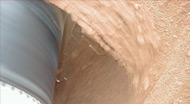Manufacturing process
In theory, producing aggregates simply involves crushing rock. In practice, it is much more complex, as standardized sizes and homogenous aggregates must be obtained.
Step 1: Supply |
|
|
Three major sources of aggregates can be identified:
Deposits of alluvial aggregates are increasingly rare, having already been largely exploited. They are gradually being replaced by marine aggregates, an excellent alternative material. The geological nature of marine aggregates is identical to rolled sand from land quarries. Marine aggregates produce high-quality concrete, adapt well to the manufacture of innovative concretes, and are therefore an important new source of supply being explored by the Group. |

The lifecycle of a quarryThe first step is to identify a site. Geological exploration is then used to evaluate the deposit's potential. The next steps are:
|
Step 2: Extraction |
|
|
Extraction is a key phase during production from solid rock, particularly because strategic choices, such as the selection of a slab for color or hardness, can make a real difference. |
|
Step 3: Crushing, Grinding, Screening |
|
|
Once extracted, the materials are transported to the processing site for scalping. This process involves removing unwanted materials, such as blocks, clay, etc. The scalped product is crushed once to transform the block into broken stone. The process is repeated as many times as necessary to obtain the desired fragment size. The resulting material is then screened to obtain aggregates of the desired grade. The larger pieces that are rejected are returned to the crusher and subsequently re-screened, with the process continuing until the desired size is obtained. Some categories of aggregates, such as sand and gravel, undergo complementary processing including washing, cycloning and scrubbing, primarily to make them cleaner. |
GlossaryAggregates, gravels, crushing... Every profession has its technical jargon! |





